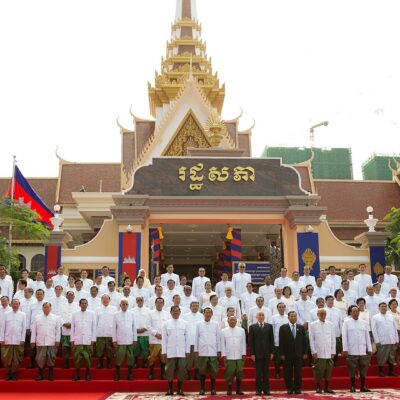The Gulf of Thailand and the Andaman Sea comprise an area that features overlapping claims to maritime jurisdiction. This case is unique: first because, geographically, the Gulf of Thailand is a semi-closed sea with Malaysia, Thailand, Cambodia, and Vietnam covering 12 nautical miles of territorial sea. Simultaneously, India shares ocean borders with Myanmar, Thailand, and Indonesia at the Andaman Sea. Due to their close proximity, all aforementioned countries have made overlapping claims to the islands around this area.
Second, other border complexities are at play. The Gulf of Thailand is a restricted and narrow water space, which makes it nearly impossible for any coastal state to fully claim entitlement to the 200 nautical mile economic exclusive zone (EEZ). Similarly, India, Myanmar, Thailand, and Indonesia all claim continental shelf boundaries which would overlap if extended to 200 nautical miles (or potentially, beyond). Given this geography, the EEZ and continental shelf boundary entitlements under the 1982 United Nations Convention on the Law of the Sea (UNCLOS) make this issue a complicated one to resolve.
Third, all the mentioned countries also have complex coastal geography, such as numerous islands, islets, and rocks, which sets a difficult basis for negotiating sovereignty claims. All these aspects have naturally compounded the possibility of disputes in these maritime domains.
Nonetheless, thus far, the Gulf of Thailand and Andaman Sea have been a classic example of countries attempting to show strong commitment to peace and stability of the adjacent waters which otherwise could be compromised by possible disputes. The cooperative behaviour demonstrated in reaching an amicable management mechanism is notable. This achievement is why Southeast Asia has been described as a ‘scene of very active and innovative ocean boundary diplomacy’.
Methods adopted to manage disputes and the reasons that influence their approaches
A series of agreements have been signed concerning the Gulf of Thailand and Andaman Sea. Most often, maritime delimitation agreements have been selected with equidistance as the applicable method for delimitation. This choice aligns with Article 15 of UNCLOS, which indicates that states must determine their territorial sea boundaries by agreement, and in the absence of agreement, the median line should be employed as the boundary unless historic title or other special circumstances warrant otherwise. In the case of overlapping EEZ or continental shelf claims, Articles 74 (1) and 83 (1) require delimitation of the EEZ and the continental shelf to be effected by agreement on the basis of international law in order to achieve an equitable solution.
In adopting an equidistance method, the countries of this particular area have demonstrated a strong conciliatory approach. For example, many disputes may arise based on offshore features due to the geographical position of these countries. Under Article 121 of UNCLOS, if a feature is considered as an island and can sustain human habitation or economic life, it is entitled to a territorial sea, EEZ, and continental shelf. This issue is a common problem in the Gulf of Thailand and Andaman Sea. The claimant state can choose between giving a reduced effect or defining the weight it wishes to give to the island. Although this choice can complicate the claim and increase tension, it has enabled compromise between those involved.
One example is the Delimitation Agreement between Myanmar-India in 1986 (Andaman Sea, Coco Channel and the Bay of Bengal). The disagreement was over the disputed Narcondam Island. Myanmar sought to claim the area along with Barren Island, the South of Narcondam, using a straight baseline cutting of the Gulf of Martaban (which connects Irrawaddy Delta to Moscos Island). After 11 years of negotiations, the dispute was resolved in 1986 with Myanmar surrendering its claims over the island and abandoning the straight baseline. Although India has the right and advantage to claim its extended zone from the island, the sovereignty claim over the Narcondam Island was settled with an equidistance line which favoured Myanmar. This method gave Myanmar approximately an extra 625 square nautical miles.
Another example is the first Vietnam delimitation agreement—the 1997 Thailand-Vietnam Delimitation. When Thailand attempted to claim its continental shelf claim against Vietnam in 1973, neither the offshore feature of Ko Losin in Thailand nor Vietnamese features in the Tho Chu archipelago were given any effect. On the other hand, during the 1971 Vietnam claim to the continental shelf, the Tho Chu archipelago was given full effect while the Ko Losin offshore feature were given none. Nevertheless, both Vietnam and Thailand retracted from their absolute positions and agreed to give due weight to both Ko Losin and the Tho Chu archipelago. The countries settled on Thailand getting two thirds of the area and Vietnam accepting one third.
In 1971, Indonesia and Thailand, regarding Continental Shelf Delimitation (Straits of Malacca and Andaman Sea), signed an agreement partially delimiting their common maritime boundary. This agreement took force in 1973, and it used a small island 30 nautical miles from the mainland for its delimitation, which was given full effect. In 1975, both countries extended their 1973 boundary north-westward into the Andaman Sea.
Further, using an archipelagic baseline as the base point of measurement, the India and Indonesia overlapping continental shelf dispute was settled with the 1974 continental shelf boundary agreement, which delineated the area between Great Nicobar Island and Sumatra. In 1977, both countries extended their 1974 boundary north-eastward into the Andaman Sea and south-westward into the Indian Ocean. Following this agreement, a similar equidistant agreement was reached between India, Indonesia, and Thailand to establish a common trijunction point in 1978. This equidistant point is from the northeast coast of Great Nicobar Island and Rondo Island, Indonesia to the southern-most island of Mu Ko Similan, Thailand.
Another instance is the 1982 Memorandum of Understanding signed between Malaysia and Thailand on delimitating the continental shelf boundary. Both parties settled with a Joint Authority, which later led to the shaping of a constitution on the joint authority. This outcome was also based on the equidistant method.
In other cases, the dispute has consisted of relevant circumstances such as geological and geomorphologic factors. An example is the 1975 Indonesia–Thailand Continental Shelf Delimitation of the Andaman Sea, where Jakarta ceded Bangkok the area beyond the equidistance line. Another case emerged with the India–Indonesia–Thailand Continental Shelf Delimitation where all three parties agreed to a trijunction point where India secured full, Thailand accepted half, and Indonesia less than half equidistance claim entitlement in 1978.
Countries in the region have also demonstrated strong willingness to cooperate regarding delimitation agreements, which have helped to address boundary issues that overlap with common deposits. These kind of agreements are especially applicable if there is a unity of deposits about which countries must communicate all information and discuss ways to effectively exploit the area. The most common category is joint development arrangements, which are usually used to overcome disputes over shared resources, especially in areas that contain hydrocarbon or petroleum and natural gas resources.
Furthermore, provisional arrangements, such as joint development or cooperation, are often adopted by Southeast Asian countries during transitional periods to avoid conflict before a final agreement is achieved. For example, the 1992 Malaysia–Vietnam Provisional Arrangement included agreements with foreign enterprises on hydrocarbon and petroleum resources and adopted a combined regime where both countries’ claims have been accommodated to exploit the area together (called the ‘Defined Area’). After five years, both parties agreed to delimit their continental shelf and EEZ boundary to the south-west of Vietnam and to the north-east of Thailand. In addition, a joint development for a small overlapping area was established in principle among Vietnam, Thailand, and Malaysia in 1999.
Provisional Arrangements can also be agreed if any issues arise in terms of capacity to develop shared resources. For instance, Malaysia’s national oil company PETRONAS, which has more capacity, assisted PETROVIETNAM in carrying out exploration. Another example is the Joint Development effort on seabed resources in the Gulf of Thailand between Cambodia and Thailand—referred as the 2001 Cambodia-Thailand Provisional Arrangement (which is not yet in force). It is a Memorandum of Understanding between the Royal Government of Cambodia and the Royal Thai Government regarding the Area of their Overlapping Maritime Claims to the Continental Shelf. After years of silence, both countries have agreed to resume talks on their overlapping claims. The faster the deal is sealed, the more both countries can benefit by producing a significant amount of oil and gas.
Factors that have fostered compromise and cooperation on maritime boundaries
First, all countries involved are coastal nations. This factor has been profoundly unifying. For example, India is a large maritime nation sitting adjacent to the Indian Ocean and the Andaman Sea; and the peace and tranquillity of surrounding waters are vital for India’s internal and external economic development. In addition, India has aspirations to project an image as a responsible maritime power and take on a leadership role in the Indian Ocean. Hence, it is natural for countries such as India to work towards good maritime governance. Furthermore, almost all the countries discussed here are closely situated to each other. They are accustomed to overlapping claims, having long had maritime boundaries that cross over the territorial seas of their neighbours and cross over the maritime jurisdictions of their neighbours close to EEZs. Such complexity can lead to maritime skirmishes. Therefore, the members of the region have learned to emphasise cooperation over conflict.
The second factor is economic. The presence of hydrocarbon resources is a major reason to adopt delimitation agreements, especially in relation to the economic development of nations which are highly dependent on income from the sea. For example, India’s willingness to cooperate with Myanmar is symbolic of their economic connectivity—the geo-economic connectedness of South Asia with the Bay of Bengal has been a major reason behind India’s inclination to strengthen its external policy with neighbouring countries. In addition, geostrategic interests also come into play in understanding India’s willingness to engage positively with Myanmar. Closely situated to India, a weak Myanmar would open up the door to the possibility of becoming more influenced by China. Hence, India more or less seeks to balance power against China.
The third factor is geostrategic. Geographically, the Gulf of Thailand and the Andaman Sea have always been an important connection between East and West international maritime trading and in the sea lanes of communication (SLOC). Be it the water adjacent to the region such as the offshore areas of southern China, the eastern side of the Andaman Sea, or even Western Pacific areas such as Papua New Guinea, this area is part of the Asian Rim in the Pacific Ocean. Those nations with claim to maritime boundaries in the area have a substantial stake in ensuring the peace and stability of the surrounding ocean space. An uninterrupted SLOC and stable maritime connectivity are key for political and economic survival. The complex coastal geography has thus influenced their cooperative behaviour.
Fourth, all countries involved have so far respected international law. Besides Cambodia, all other countries in Southeast Asia are parties to the 1982 UNCLOS; so, the equidistance line which is recognised as having a primary place in delimitation methodology by the International Court of Justice has been accepted as a way to resolve maritime border issues.
Lastly is the ‘ASEAN spirit’ which aims to overcome dissent through tolerance, understanding and mutual respect. ASEAN has fostered a regionalism in addressing issues concerning the region, including maritime delimitation approaches. ASEAN members consist mainly of smaller powers that are developing (except for Singapore) and surrounded by water (except for Laos). It is therefore vital to all players that there is no conflict between neighbouring countries. Peace provides a stable environment for economic interaction and allows for the exploration of resources for shared economic benefit. In addition, an intact maritime boundary agreement will prevent opportunities for interference.
It is for these reasons there are so many maritime delimitation agreements that avoid conflict and dispute in the Gulf of Thailand and Andaman Sea. This diplomacy has provided a stable environment in which individual states and the region as a whole can pursue national interests.
This article is part of the ‘Blue Security’ project led by La Trobe Asia, University of Western Australia Defence and Security Institute, Griffith Asia Institute, UNSW Canberra and the Asia-Pacific Development, Diplomacy and Defence Dialogue (AP4D). Views expressed are solely of its author/s and not representative of the Maritime Exchange, the Australian Government, or any collaboration partner country government.
Image: Pattaya City at night. Credit: weichen_kh/Flickr.




